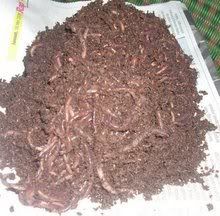Earthworm is the usual name for the largest members of Oligochaeta (which is either a class or subclass depending on the author) in the phylum Annelida. In classical systems they were placed in the order Opisthopora, on the basis of the male pores opening posterior to the female pores, even though the internal male segments are anterior to the female. Theoretical cladistic studies have placed them instead in the suborder Lumbricina of the order Haplotaxida, but this may again soon change. Folk names for the earthworm include "dew-worm", "rainworm", "night crawler" and "angleworm" (due to its use as fishing bait).
The major benefits of earthworm activities to soil fertility can be summarized as:
Biological. In many soils, earthworms play a major role in converting large pieces of organic matter (e.g. dead leaves) into rich humus, and thus improving soil fertility. This is achieved by the worm's actions of pulling down below any organic matter deposited on the dried dirt, such as leaf fall or manure, either for food or when it needs to plug its burrow. Once in the burrow, the worm will shred the leaf and partially digest it, then mingle it with the earth by saturating it with intestinal secretions. Worm casts (see below) can contain 40% more humus than the top 6" of soil in which the worm is living.
Chemical. As well as dead organic matter, the earthworm also ingests any other soil particles that are small enough—including stones up to 1/20 of an inch (1.25mm) across—into its gizzard wherein minute fragments of grit grind everything into a fine paste which is then digested in the stomach. When the worm excretes this in the form of casts which are deposited on the surface or deeper in the soil, minerals and plant nutrients are made available in an accessible form. Investigations in the US show that fresh earthworm casts are 5 times richer in available nitrogen, 7 times richer in available phosphates and 11 times richer in available potash than the surrounding upper 6 inches (150 mm) of soil. In conditions where there is plenty of available humus, the weight of casts produced may be greater than 4.5 kg (10 lb) per worm per year, in itself an indicator of why it pays the gardener or farmer to keep worm populations high.
Physical. By its burrowing actions, the earthworm is of great value in keeping the soil structure open, creating a multitude of channels which allow the processes of both aeration and drainage to occur. Permaculture co-founder Bill Mollison points out that by sliding in their tunnels, earthworms "act as an innumerable army of pistons pumping air in and out of the soils on a 24 hour cycle (more rapidly at night)". Thus the earthworm not only creates passages for air and water to traverse, but is itself a vital component in the living biosystem that is healthy soil.
Various species of worms are used in vermiculture, the practice of feeding organic waste to earthworms to decompose (digest) it, a form of composting by the use of worms. These are usually Eisenia fetida (or its close relative Eisenia andrei) or the Brandling worm, also known as the Tiger worm or Red Wiggler, and are distinct from soil-dwelling earthworms.
Earthworms are sold all over the world. The earthworm market is sizable. According to Doug Collicut (see "Nightcrawler" link below), "In 1980, 370 million worms were exported from Canada, with a Canadian export value of $13 million and an American retail value of $54 million."
Earthworms are also sometimes sold as food for human consumption. Noke is a culinary term used by the Māori of New Zealand to refer to earthworms which are considered delicacies.
A report on biodiversity published by the Irish Government in May 2008 estimated the activities of the earthworm to be worth a minimum of €723 millon per annum to Irish agriculture. Taken From http://en.wikipedia.org/wiki/Earthworm

gelik aku nengok cacing ni....eee
No comments:
Post a Comment